Sony AIBO ERS110 User Manual

3-867-061-11(1)
Entertainment
Robot
ERS-110
Operation Manual
C 1999 by Sony Corporation

Entertainment Robot
“AIBO” ERS-110
Operation Manual

“OPEN-R” is the standard interface for the entertainment robot system that Sony is actively promoting. This interface expands the capability of the entertainment robot through a flexible combination of hardware and interchangeable software to suit various applications.
“AIBO” ERS-110 conforms to the OPEN-R version 1 (software specifications).

“AIBO” is the name given to the Sony entertainment robot. Developed to encourage human and robot interaction, AIBO creates and introduces you to new pleasures and lifestyles.
The name “AIBO” is coined from the words “A.I. (Artificial Intelligence),” “eye” and “robot.” In Japanese, the word “aibou” means “partner” or “pal.”

Safety Information
Owner's Record
The model number and serial number are located on the bottom of the station. Record the serial number in the space provided here.
Refer to the model and serial number when you call your Sony AIBO Customer Link.
Model Number: ERS-110 Serial Number:
WARNING
•To prevent fire or shock hazard, do not expose the robot to rain or moisture.
•To avoid electrical shock, do not open the cabinet. Refer servicing to qualified personnel only. (Contact the AIBO Customer Link.)
•Parents—Periodically examine the transformer for conditions that may result in the risk of fire, electric shock, or injury to persons (such as damage to the cords, blades, housing) and that in the event of such conditions, the transformer should not be used until properly replaced.
•Not Recommended for Children Under 8 Years.
•Sound controller—Do not mix old and new batteries.
•Do not mix alkaline, standard (carbon-zinc) or rechargeable (nickelcadmium) batteries.
DISPOSAL OF LITHIUM ION BATTERY
You can return your unwanted lithium ion batteries to your nearest Sony Service Center.
Note
In some areas the disposal of lithium ion Batteries in household or business trash may be prohibited.
For the Sony AIBO Customer Link you call 1-800-427-2988 in the United States or contact via email at support@aibosony.com .
!Do not handle damaged or leaking lithium ion batteries.
!Danger of explosion if battery is incorrectly replaced. Replace only with the same or equivalent type recommended by the manufacture. Discard used batteries according to the manufacturer's instructions.
!The battery pack used in this device may present a fire or chemical burn hazard if mistreated. Do not disassemble, heat above 140 °F (60 °C) or incinerate. Dispose of used battery promptly. Keep away from children.
4
Regulatory Information
This equipment has been tested and found to comply with the limits for a Class B digital device, pursuant to Part 15 of the FCC Rules. These limits are designed to provide reasonable protection against harmful interference in a residential installation. This equipment generates, uses and can radiate radio frequency energy and, if not installed and used in accordance with the instructions, may cause harmful interference to radio communications. However, there is no guarantee that interference will not occur in a particular installation. If this equipment does cause harmful interference to radio or television reception, which can be determined by turning the equipment off and on, the user is encouraged to try to correct the interference by one more the following measures:
•Reorient or relocate the receiving antenna.
•Increase the separation between the equipment and receiver.
•Connect the equipment into an outlet on a circuit different from that to which the receiver is connected.
•Consult the dealer or an experienced radio/TV technician for help.
•You are cautioned that any changes or modifications not expressly approved in this manual could void your authority to operate this equipment.
•The shielded interface cable recommended in this manual must be used with this equipment in order to comply with the limits for a digital device pursuant to Subpart B of Part 15 of FCC Rules.
5
How to use this instruction manual
Thank you for purchasing “AIBO” ERS-110. This manual will assist you in building your new relationship with this entertainment robot. Before operating AIBO, please thoroughly read this manual and retain it for future reference.
Getting started
To get AIBO to move
See “Getting started” on page 27. Preparation, basic operation and what you should do after playing are described.
To enjoy AIBO’s autonomous activity, its performances or AIBO in a game
See respectively, “Living with AIBO” on page 49, “Enjoying AIBO’s performances” on page 62 and “Playing games” on page 66.
Understanding AIBO for a fulfilling partnership
To understand AIBO in detail
See “Introduction to ERS-110 “AIBO”” on page 12. You can find out exactly what kind of robot AIBO is.
To communicate with AIBO
See “Features of AIBO” on page 13, “Capabilities of the sound controller” on page 16, “Communicating via touch sensor” on page 52 and “Communicating via objects (the ball)” on page 52. You can understand how to communicate with AIBO through its senses of touch, vision and hearing.
To understand the activity pattern of AIBO
See “AIBO’s motion modes” on page 44. You will be able to find out about AIBO’s other possibilities than as an autonomous robot.
Getting to know the mind of autonomous AIBO
See “A psychological peek into your robot” on page 54. You can understand principle of AIBO’s activity in the autonomous mode.
6
Additional information
To charge AIBO
See “Charging the battery pack” on page 74.
To search for information
See “List of commands” on page 91, “List of lamps/indicators” on page 95 and “Index” on page 103.
If you wonder, “Is it broken?”
See “Troubleshooting” on page 86.
“AIBO,” the AIBO logo, “OPEN-R” and the OPEN-R logo are trademarks of Sony Corporation.
7

Table of Contents |
|
|
Chapter 1 |
Meet AIBO |
|
Introduction to “AIBO” ERS-110............................................................ |
12 |
|
What is an autonomous robot? ....................................................... |
12 |
|
Features of AIBO .............................................................................. |
13 |
|
Capabilities of the sound controller .................................................... |
16 |
|
Commands ........................................................................................ |
16 |
|
Sound controller features ................................................................ |
16 |
|
Unpacking ............................................................................................... |
|
18 |
AIBO .................................................................................................. |
|
18 |
Supplied accessories ......................................................................... |
18 |
|
Index to parts and controls ................................................................... |
20 |
|
AIBO .................................................................................................. |
|
20 |
Station ............................................................................................... |
|
23 |
Sound controller ............................................................................... |
24 |
|
Chapter 2 |
Getting started |
|
Preparation ............................................................................................. |
|
28 |
Preparing AIBO ................................................................................. |
28 |
|
Preparing the station ....................................................................... |
30 |
|
Preparing the sound controller ....................................................... |
31 |
|
Playing for the first time ....................................................................... |
32 |
|
Enjoying AIBO’s autonomous activity ............................................. |
32 |
|
Performing ........................................................................................ |
34 |
|
After playing .......................................................................................... |
|
37 |
Placing AIBO on the station ............................................................. |
37 |
|
Taking AIBO off the station ............................................................. |
39 |
|
When not playing with AIBO ................................................................. |
40 |
|
When you are going out / going to sleep ....................................... |
40 |
|
When going out for long ................................................................. |
42 |
|
8

Chapter 3 AIBO’s four modes — How to interact with AIBO |
|
AIBO’s motion modes ............................................................................ |
44 |
About each motion mode ................................................................ |
44 |
The different modes ......................................................................... |
46 |
Correlation of motion modes .......................................................... |
47 |
Chapter 4 Living with AIBO — AIBO, an independent roommate |
|
AIBO’s autonomous activities ............................................................... |
50 |
Engaging the autonomous mode ................................................... |
50 |
Communicating via touch sensor .................................................... |
52 |
Communicating via objects (the ball) ............................................. |
52 |
A psychological peek into your robot .................................................. |
54 |
Emotions ........................................................................................... |
54 |
Instincts ............................................................................................. |
55 |
Education .......................................................................................... |
56 |
Growth .............................................................................................. |
56 |
Body language .................................................................................. |
57 |
Other robotic expressions ................................................................ |
59 |
Naps and bedtime ............................................................................ |
60 |
Chapter 5 Playing with remote-controlled AIBO |
|
Enjoying AIBO’s performance ............................................................... |
62 |
Setting AIBO to the performance mode ......................................... |
62 |
Changing the movement style ........................................................ |
63 |
Asking AIBO for a particular performance ..................................... |
64 |
Playing games ........................................................................................ |
66 |
Operating AIBO in the game mode ................................................ |
66 |
Controlling two AIBOs ..................................................................... |
69 |
Playing games with AIBO ...................................................................... |
71 |
Soccer ................................................................................................ |
71 |
Labyrinth ........................................................................................... |
72 |
Stick ................................................................................................... |
72 |
9

Chapter 6 Charging and adjustments |
|
Charging the battery pack and adjusting the volume |
....................... 74 |
Charging the battery pack ............................................................... |
74 |
Replacing the battery pack .............................................................. |
76 |
Adjusting the volume ....................................................................... |
79 |
Chapter 7 Additional information |
|
Notes on use ........................................................................................... |
82 |
Troubleshooting ..................................................................................... |
86 |
AIBO .................................................................................................. |
86 |
Autonomous mode .......................................................................... |
87 |
Performance mode ........................................................................... |
88 |
Game mode ...................................................................................... |
89 |
Station ............................................................................................... |
90 |
Sound controller ............................................................................... |
90 |
List of commands ................................................................................... |
91 |
Numeric commands and single sound commands ......................... |
91 |
Game commands .............................................................................. |
94 |
List of lamps/indicators ......................................................................... |
95 |
Lamps on AIBO ................................................................................. |
95 |
Indicators on the station .................................................................. |
97 |
Lamps on the sound controller ........................................................ |
98 |
Limited warranty ................................................................................... |
99 |
Service procedure ................................................................................ |
101 |
Specification ......................................................................................... |
102 |
Index ...................................................................................................... |
104 |
10

Meet AIBO
This chapter introduces you to the entertainment robot “AIBO” ERS-110 and its supplied accessories.

Introduction to “AIBO” ERS-110
“AIBO” ERS-110 is Sony’s first robot designed for home entertainment. Utilizing advanced technology, this “entertainment robot” expands on the features of robots which have existed only in the realm of science fiction or in special laboratories.
There have been other robots for entertainment, such as battling robots operated by remote control, stuffed animal robots that giggle when tickled, and robots controlled by computer. However, the greatest difference between those robots and AIBO is that AIBO is an “autonomous” robot.
What is an autonomous robot?
AIBO was created to encourage human and robot coexistence. It can move around on its own, as it is equipped with all the
necessary hardware such as the brain, sensors, and power switch. In addition, its software enables AIBO to have emotions, instincts, learning ability and capacity to mature. Therefore, it requires no external control or human instruction for movement. AIBO is a robot, but a one which lives at home and communicates with people, expressing emotions, learning and growing up, and acting under its own judgement—this is an “autonomous robot.”
Each AIBO turns out differently, as its behavioral patterns continuously change. This is because AIBO acts based upon its feelings and instincts, then learns from the result of experience, all the while maturing into a full-fledged robot.
When in a bad mood, AIBO will not listen to what people order, whereas in a good mood, it may entertain you with its favorite performance.
The key to get along with AIBO is to understand its autonomous nature, and help it learn and grow.
12

Features of AIBO
To realize AIBO’s greatest feature, the autonomous behavior, AIBO has various functions and capabilities. There are also other ways to enjoy AIBO other than as an autonomous robot.
A four-legged robot
To comfortably coexist with people, AIBO was designed with the four-legged appearance of a dog or cat, animals which usually have long-term, friendly relationships with people. It walks on four legs which are jointed and moves them to sit or lie down. It also uses the legs to express its emotions or entertain you with its favorite performance.
Various senses
AIBO has sensors corresponding to human senses, which allow it to perceive its environments and communicate with people.
• Touch: |
AIBO’s head is the sensor for receiving personal |
|
contact by touch. |
• Audition: AIBO receives sounds through a stereo microphone.
|
AIBO has a perfect pitch and responds to certain |
|
combinations of musical tones (commands) that |
|
deliver instructions to it. |
• Vision: |
AIBO has a built-in color camera and distance |
|
sensor which are used to look for its favorite colors |
|
or to avoid obstacles. |
• Balance: |
Using its acceleration sensor, AIBO maintains its |
|
balance and recognizes when it falls. |
Communicating with people
AIBO speaks to us by way of musical tones (robot language). It also expresses its joy or desires through body language. The eye lamps are used to express emotions or give a yes or no response. You can also initiate communication by presenting a ball to AIBO. When approving or scolding AIBO, you can pat or hit the touch sensor on its head.
Introduction to ERS-110 “AIBO”
 Touch
Touch

 Audition
Audition
Vision
13

Introduction to ERS-110 “AIBO”
Natural motions
A total of 18 joints (which is technically called “18 degrees of freedom”) enables AIBO to move in a natural, smooth manner. All the joints are cooperatively controlled and allow not only basic movements like walking, sitting or lying down, but also movements like looking around, tilting its head, or waving its paws. AIBO can use more complicated body language, and will even try to show off when in a good mood.
AIBO performance
Other than playing with it as an autonomous robot, you can enjoy pre-programmed performances by switching it to the performance mode. The performances prepared for AIBO can be changed, and new original motions can be added with a separate software (not supplied) called ERF-510 AIBO Performer Kit. This software can enhance AIBO’s existing movements, as well as help you create original robot motions.
Playing games
Once switched to the game mode, AIBO loses its autonomy and reacts solely to human commands. In addition to simple movements, such as moving back and forth and changing directions, it can kick, show joy of winning, display sorrow after losing a game, hold something in its mouth and let it go. Using these functions, AIBO can play games such as robot soccer.
14
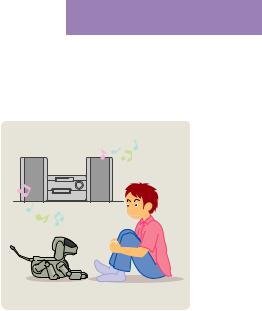
Introduction to ERS-110 “AIBO”
A robot in your home
There are still endless possibilities for AIBO and you as partners. From the time of its birth, as it continues to live a life in touch with humans, it will develop as not only a robot, but a companion. We hope you enjoy this new kind of entertainment— home entertainment that is born the moment you decide to begin a life involving AIBO.
15

Capabilities of the sound controller
AIBO has perfect pitch and can distinguish musical tones. This feature makes it possible to send commands to AIBO through combinations of certain musical tones. This means you can even control AIBO through a musical instrument or by whistling, as long as the combination of notes and pitch are correct. However, it takes some practice to hit just the right sounds that AIBO will recognize. Therefore, a sound controller, which makes it easy to produce sounds AIBO recognizes, is included. This section introduces you to commands and sound controller features. For details on how to use it, see chapters 2, 4 and 5.
Commands
Commands are combinations of specific musical tones. Various commands are assigned to correspond to different note combinations. Use these commands to change AIBO’s motion modes (e.g., changing from the autonomous mode to the remote-control mode), or to enter a command for an action in the game mode or the performance mode.
Each command consists of a combination of three individual tones all in the same octave (from C to B) such as “C-D-E” and “F-E-C.” AIBO recognizes a total of approximately 40 different commands.
Sound controller features
Sound controller (supplied) has three user-friendly features, including the ability to switch the command transmission method.
(1) Three types of operating commands
Three types of operating commands are provided, geared to different types of play. As described in the following, the functions assigned to the number/symbol buttons (command buttons) change according to the operating command.
16

Capabilities of the sound controller
•Numeric commands: The entered combination of numbers (command number) is sent as a command such as “Stand up” or “Sit down.”
•Single sound commands: Like a musical instrument, individual musical tones are output by the sound controller when the command buttons are pressed. This is useful when you want to hear the tones as you send a command.
•Game commands: Game-only commands such as “Move forward” are assigned to the command buttons. This is useful when playing games such as soccer.
In this operation manual, most of the commands sending procedures are written as numeric commands. When sending commands in the single sound system, refer to “List of commands” on page 91.
(2) Easy switching between command types
The same commands can be sent in two different octaves (command type A and B) with the sound controller. This is useful when there are two AIBOs involved in a game (see page 69), where commands must be distinguished for each robot. You can set the command type using the switch on the side of the sound controller. For details, see “Index to parts and controls” on page 24.
(3) Auto OFF function
You can turn the sound controller on by pressing the “C” button. The power turns off automatically if the sound controller is not operated for three minutes.
17

Unpacking
Check to make sure that you have the following items:
AIBO
Entertainment Robot “AIBO” ERS-110
Supplied accessories
Station
The station is used to charge AIBO’s batteries, and also serves as AIBO’s home base.
18

Unpacking
Sound controller
You can control AIBO by sending commands (musical tones).
ON |
GAME |
VOL |
C |
|
|
|
SEND |
|
1 |
2 |
3 |
A |
A |
B |
4 |
5 |
6 |
F |
G |
G |
PICKUP |
|
RELEASE |
7 |
8 |
9 |
D |
E |
F |
LOSE |
TRACK |
WIN |
|
0 |
|
C |
C |
D |
Ball
This is AIBO’s special toy. You can also use this for robot soccer.
“Memory Stick” and case
The “Memory Stick” stores AIBO-ware (AIBO’s operating program). You can also save the data of AIBO’s activities with it.
AC adapter
The AC adapter allows AIBO to receive power from an AC power supply when AIBO is mounted on the station. Always keep the station and AC adapter connected to the AC power supply.
AIBO power supply: ERA-110B lithium ion battery pack (2)
AIBO operates only with the ERA-110B battery pack.
Remote controller power: Size AA (R6) battery (2)
Documentation
Operation manual
AIBO logo sticker
Certificate of Authenticity
19
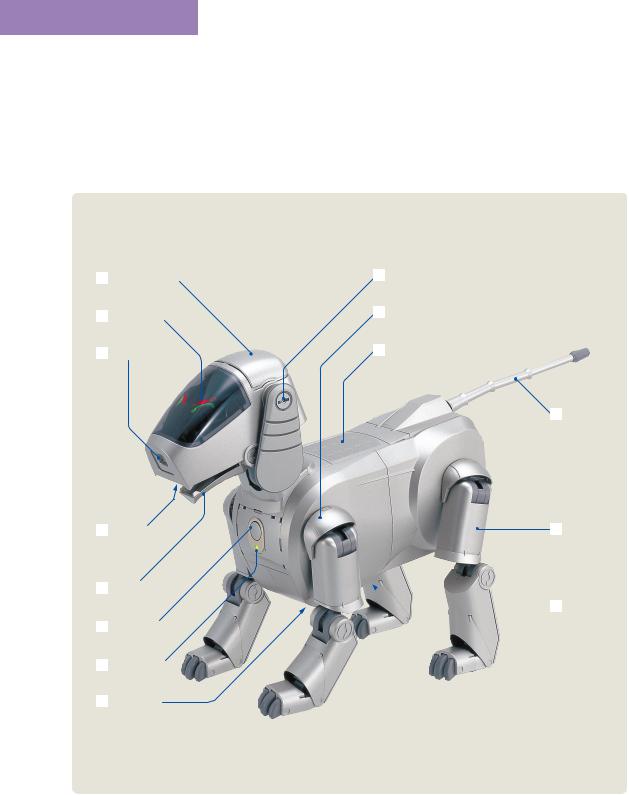
Index to parts and controls
AIBO
Refer to the pages indicated in parentheses ( ) for relating information.
1 Touch sensor
2 Eye lamps
3 Color camera
4 Speaker
5 Mouth
6 Pause button
7 Chest lamp
8Air intake port
9 Stereo microphone
q; Shoulder cover
qa Exhaust port
qs Tail
qd Legs
 qf Charging terminal
qf Charging terminal
20

1Touch sensor (52)
Allows AIBO to develop tactile relations when a person taps or pets it.
2Eye lamps (59, 95)
Light up in red or green, and indicate AIBO’s emotional state or response to personal contact.
3Color camera (52)
Allows AIBO to search objects and recognize the color, shape and its movement. AIBO can measure the distance to an object and avoid obstacles using this CCD color camera and the built-in distance sensor.
4Speaker
Emits combinations of musical tones (robot languages) and sound effects.
5Mouth (72)
Holds objects, and also indicates AIBO’s emotional state.
6Pause button (28, 32)
Press this button to pause AIBO when changing batteries, if AIBO has an internal trouble or if your hand gets caught between its joints.
7Chest lamp (59, 96)
Indicates AIBO’s state of activity.
8Air intake port
Takes air into AIBO to prevent internal heat buildup.
9Stereo microphone (35)
Gathers sound and allows AIBO to distinguish musical tones, and its direction.
0Shoulder cover
Protects AIBO’s joints. If your fingers get caught in the cover, it automatically opens.
qa Exhaust port
Emits air from the internal cooling device.
q sTail
Shows AIBO’s emotional state by wagging.
qd Legs
Allow AIBO to walk and also indicate AIBO’s emotional state.
q fCharging terminal
Contacts with that of the station when charging the battery.
Index to parts and controls
Notes
•Do not put a sticker on the color camera or head cover.
•Be sure to keep the shoulder cover closed except in case of an emergency.
•Do not put a sticker on the movable parts or insert anything between them. Doing so may obstruct AIBO’s movement.
•Do not block the air intake port or exhaust port with your hand or by putting a sticker on them. Doing so may cause internal heat buildup.
•Do not touch the charging terminal directly with your hand. Doing so may soil the terminal and cause poor contact.
•Pick up AIBO by the body, not by its extremities (see page 29).
21
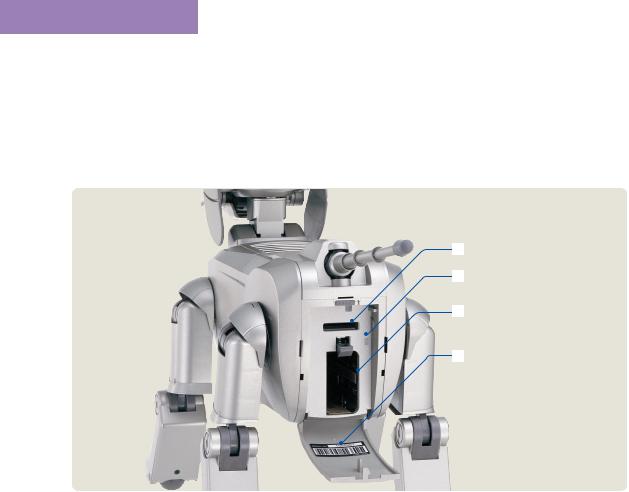
Index to parts and controls
Rear of AIBO
1 “Memory Stick” slot
2 “Memory Stick” access lamp
3 Battery slot
4 Serial number label
1 “Memory Stick” slot (29)
2“Memory Stick” access lamp (96)
Lights up when loading/saving the data of AIBO’s activities in the “Memory Stick.”
3 Battery slot (29, 77)
4Serial number label
The label with your AIBO’s serial number.
22

Index to parts and controls
Station
Refer to the pages indicated in parentheses ( ) for relating information.
1 POWER indicator
2 MAIN indicator 
3 SUB indicator
4 Extra battery slot
1 POWER indicator (30, 74, 97)
Lights up in green when the station is turned on.
2MAIN indicator (75, 97)
Lights up/flashes in orange (when AIBO is charging) or green (when AIBO is fully charged), indicating the charging condition of AIBO.
3SUB indicator (75, 97)
Lights up/flashes in orange (when battery is charging) or green (when battery is fully charged), indicating the charging condition of the extra battery pack.
4 Extra battery slot (75)
5AC IN power supply connector (30)
Connects the AC adapter.
6Charging terminal
A terminal for charging AIBO on the station.
Note
5AC IN power supply connector
6 Charging terminal
Do not touch the charging terminal directly with your hand. Doing so may soil the |
23 |
terminal and cause poor contact. |
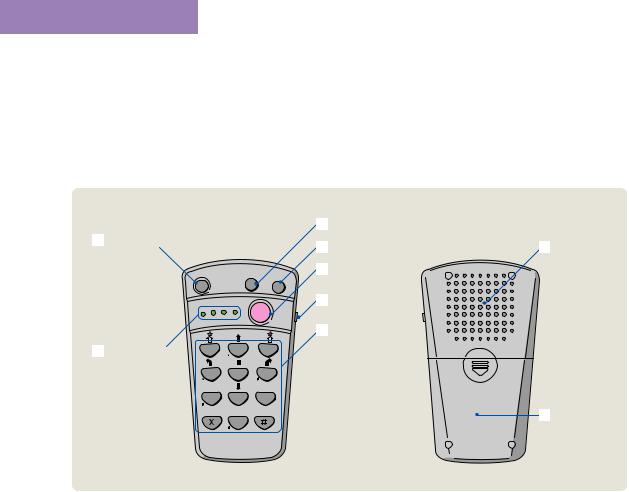
Index to parts and controls
Sound controller
Refer to the pages indicated in parentheses ( ) for relating information.
Face |
Back |
3 GAME button
1 C (ON) button
ON |
GAME |
VOL |
|
C
4 VOL button |
8 Speaker |
5 SEND button
|
|
|
|
6 Command |
|
|
|
SEND |
type switch |
|
|
|
|
7 Command |
2 Controller |
A 1 |
A 2 |
B 3 |
buttons |
|
||||
operation |
4 |
5 |
6 |
|
indicators |
|
|||
|
F |
G |
G |
|
|
PICKUP |
|
RELEASE |
|
|
7 |
8 |
9 |
|
|
D |
E |
F |
9 Battery |
|
LOSE |
TRACK |
WIN |
|
|
|
0 |
|
compartment |
|
C |
C |
D |
1C (ON) button (34)
Press this button to turn the sound controller on or to cancel the entering of the numeric command. The power turns off automatically if the sound controller is not operated for three minutes.
2Controller operation indicators (34, 98)
Four lamps light up in green or orange (the color depends on the command type), and indicate the operating commands of the sound controller or the state of entering/sending commands.
3GAME button (66)
When using numeric commands or single sound commands, press this button to set the sound controller to emit game commands and also to set AIBO to the game mode. When you press this button once more, the operating command type is turned to the previous one and AIBO resumes the autonomous mode.
24

Index to parts and controls
4VOL button
Press this button to adjust the volume of the sound controller. You can raise and lower the volume in three levels.
5SEND button (35)
When set for numeric commands, enter the command number and press this button to send a command. When you press this button without entering the command number, the same command as entered just before is sent once more.
6Command type switch (17, 34)
Selects the command type of the sound controller. Command type A corresponds to the lower octave (C5 to B5: 523.25 - 987.76 Hz), and command type B corresponds to the higher octave (C6 to B6: 1046.5 - 1975.53 Hz).
A:Command type A / numeric commands
B:Command type B / numeric commands
L: Command type A / single sound commands
H: Command type B / single sound commands
7Command buttons (16, 91, 94)
Press these buttons to enter or send commands. The functions assigned to these buttons change according to the operating command type.
Printed symbols of the command button
Symbol of movements of the game commands
|
1 |
|
A |
Musical tones of the single |
Numbers of the numeric |
sound commands |
commands |
8Speaker (35)
Emits the musical tones.
9 Battery compartment (31)
25

Getting started
This chapter introduces you to the basic features of AIBO—The autonomous mode and the remote-control mode by using the sound controller. After playing with AIBO, place it on the station.

Preparation
First of all, get AIBO ready to move.
Preparing AIBO
Install the battery pack and insert the “Memory Stick” into AIBO.
AIBO has been set to the pause mode at the factory (the pause button on its chest is pressed down).
The battery pack is fully charged before it leaves the factory. With normal use, the battery pack should last about an hour. For details on charging the battery pack, see page 74.
1 Make sure that the pause button on the chest is pressed down.
The button is pressed down about 1 mm.
2 Hold securely by the body and open the rear cover.
Slide the unlock button to open the cover.
Unlock button
Notes
•Pick up AIBO by the body, not by its extremities.
•Do not touch the charging terminal on the underside of AIBO directly with your hand. Doing so may soil the terminal and cause poor contact.
28
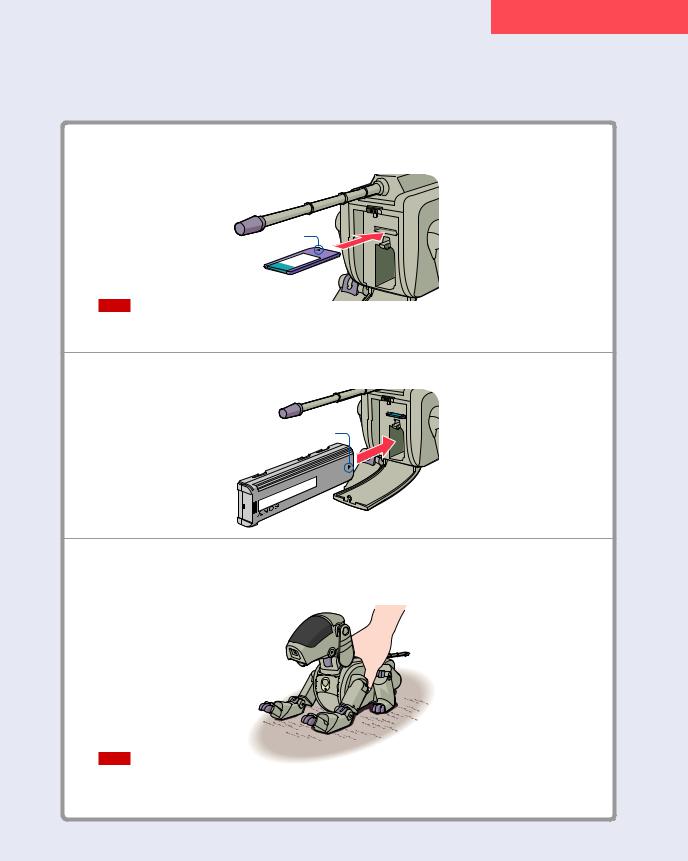
Preparation
3 Insert the supplied “Memory Stick” arrow-wise with the label side up.
Insert so that only the colored part of the label is visible.
Note
Do not set the safety switch of the “Memory Stick” to “LOCK” (see page 83). If you do so, you cannot save the data of AIBO’s learning and maturation process.
4 Insert the battery pack arrow-wise until it clicks.
Arrow
5 Close the rear cover, then place AIBO on the floor as shown below.
Place it on a flat surface that is not too slippery. Choose a quiet place so that AIBO can hear the musical tones of the controller.
Note
Be sure to place AIBO on the floor as shown above. This will prevent AIBO from moving unexpectedly and being damaged when you press and release the pause button to start AIBO.
29
